ABSTRACT
With the rapid development of global economic integration, many enterprises outsource their logistics to vendors to centrally develop their own core interests. Secondly, the emphasis on sustainability makes people pay more attention on a series of environmental problems arising in logistics. Green logistics enterprises not only improve their economic efficiency, but also enhance their competitiveness and optimize their environmental friendly benefits. Based on the aforementioned facts, this paper explores the factors involved in the selection of green logistics companies. Research tools used include an expert survey questionnaire and interviews with experts. Data collected were analyzed, leading to addressing of key success factors categorized into four dimensions (environmental, resource, economic and technical attributes), and include thirteen criteria (atmospheric pollution assessment, solid waste pollution facilities and equipment evaluation, evaluation of noise pollution, waste water pollution assessment, recycled materials utilization, use of equipment resource, the use of green energy resources, logistics cost, logistics service performance, the cost of ecological environment, progressiveness of logistics equipment, information technology of logistics management and logistics capability). Finally, decision-making trial and evaluation laboratory (DEMATEL) is used to analyze key success factors, showing the advanced logistics equipment is the most important factor in the selection.
Key words: Green logistics manufacturers, supplier selection,; decision laboratory analysis.
In recent years, with the rapid development of regional economic integration and the significant progress of science and technology, international competition among global economics and trade development is becoming increasingly fierce. At the same time, due to the rapid development of the Internet era, enterprises are facing increasingly complex external environment. In order to enhance product and service quality, and to pursue the lowest cost leadership, enterprises have to focus their resources and strengths on the most advantageous core niche. Therefore, enterprises are increasingly interested in outsourcing logistics activities, which is the supplier logistics. Logistics activities and the development of the social economy are internally and externally related. Economy develops along with the development of logistics, however, too frequent logistics development will cause environmental pollution to the social environment; thus causing obstacles to economic development. Therefore, manufacturers resort to respond to the continuous emphasis on environmental issues using green supply chain. Green supply chain refers to the products achieving minimum pollution but maximum profits from material acquisition, manufacturing, packaging, storage, transportation, usage and scrap recycling.
In other words, green logistics is the most important part in the green supply chain, which has caused high concerns in the academic circles and among enterprise production managers. With deterioration of the environment, people pay more attention on environmental protection. How to scientifically and reasonably choose green logistics companies becomes a problem faced by many enterprises. Therefore, this paper constructs the evaluation model of green logistics companies. It can assess the environmental performance of green logistics companies, and also provide enterprises with an objective choice of green logistics firms. Also, the ability of green logistics is fully considered in the construction of an evaluation model of green logistics companies , so that enterprises cannot only reduce the cost to a certain extent, but also get more economic benefits in the selection of logistics companies. What is more, pollution of logistics activities to the environment is reduced to the maximum extent, so as to better promote the strategy of sustainable development.
Literature overview
Secondary data of green logistics companies are mostly concentrated on the importance of green logistics, supplier selection and evaluation. For example, when considering the analysis of the current situation of logistics in developed countries, as well as assessing the gap in the development of green logistics in China, Sun (2012) contended that as green logistics is still in the initial stage, effective measures should be taken to quickly upgrade the construction of green logistics. Guochuan (2010) believes that the development of green logistics meets the needs of the development of the world economy, plays an important role in sustainable development and improves the competitiveness enterprises. Meantime, he puts forward that one should strengthen the construction of green logistics. Furthermore, by establishing the green supplier evaluation system, and evaluating the green supplier selection by the use of Fuzzy-AHP and fuzzy evaluation method, Wan (2010) asserts that green supply chain management can improve the environmental and economic benefits of enterprises, greatly enhancing the enterprise’s competitiveness . Yuan (2014) used VIKOR method to clarify the validity of evaluation criteria and decision method for supplier selection, in contrast with the TOPSIS method from theory, numerical experiments and sensitivity analysis.
Zheng (2015) integrated the green competitiveness index into the establishment of evaluation index system for logistics supplier, to establish hybrid multiple criteria decision fuzzy model for the selection of logistics supplier. Furthermore, domestic and foreign scholars conducted a lot of research on the selection of supplier selection, which mainly concentrates on standard for supplier evaluation, criteria and methods. But there is little analysis on key success factors of green logistics companies. This paper constructs evaluation model of green logistics companies at first, and then uses decision-making trial and evaluation laboratory (DEMATEL) for analysis of key factors to provide reference for manufacturers’ reasonable and effective selection of green logistics enterprise. Results will help to address the reduction of environmental pollution caused by logistics activities, and consequently lead to promotion of the strategy of sustainable development.
This research adopted the DEMATEL method following the success of other researchers. Wu et al. (2014) adopted DETAMEL to analyze various risk factors of SaaS by the construction of visual matrix , and calculated the causal relationship between the factors and the relative importance, so as to find out the key factors influencing the SaaS, which provides credible basis for enterprise’s scientific adoption of SaaS decisions. In order to understand the impact of consumers on mobile banking services, Lin et al. (2012) focused on evaluating system quality, information quality and service quality to assess the tendency of consumers. Especially, the interdependent relationship between DEMATEL and ANP for solving problems is taken to select desired portfolio of consumers. Hsu et al. (2007) demonstrated that Fuzzy DEMATEL method usefully and effectively meets demands of customers. Due to the vital importance of supplier to supply chain integration, Chang et al. (2011) designed the fuzzy DEMATEL questionnaire, hoping to identify the key factors that affect the selection of suppliers. Finally, Chang et al. (2011) found that stable delivery is the most influential. According to Ashtiani and Bosak (2013), “The DEMATEL method originated from the Geneve Research Centre of the Battelle Memorial Institute. DEMATEL built on the basis of graph theory, enabling analyses and solving problems by visualization method. This structural modeling approach adopts the form of a directed graph, a causal-effect diagram, to present the interdependence relationships and the values of influential effect between factors” (p.498). The analysis steps of DEMATEL adopted in this paper are as follows:
A. Understand the problems and define guidelines: The problem needs to be thoroughly understood and to list the guidelines in the system and explain them.
B. Determine the relevance of criteria: According to the principles of criteria, standards to evaluate influence are designed to explain the relationship between them. Grade range from 0 to 5, where 0 means no influence, 1 represents little impact, 2 symbolizes low impact, 3 means moderate degree, 4 means high degree and 5 means very high impact, to evaluate the importance of each criterion.
C. Establish correlation matrix: When the degree of influence is known, the association between criteria can be expressed by matrix. Normalized direct relation matrix, I-X matrix, I-X inverse matrix and total influence relation matrix are obtained sequentially from the initial matrix. The initial matrix, known as the initial direct relation matrix , compares the characteristics of factors in accordance with the relative influence, and generates n * n direct relation matrix X, such as Formula 1, among which each value Xij (i = 1, 2,... N, j = 1, 2,... (n) indicates the direct relationship between factor i with j.



The normalized direct relationship matrix can be calculated in two kinds of practices, including taking matrix column and the maximum as normalized reference, as well as moment array or matrix row and maximum as normalized reference. This research adopts the array and the maximum as normalized reference, represented by S as Formula 3. The average matrix A multiplied by S to directly get normalized direct relation matrix N, is shown as Formula 4.
After knowing the normalized direct relation matrix N, the total influence relation matrix T (direct and indirect influence relation matrix) can be obtained by Formula (5), in which I is the unit matrix.

D. Calculate (D+R) centrality and (D-R) cause degree: Factor r represents total influence relationship matrix, and T is representative of column to get sum r as Formula (6). Then C is taken as T row representative to get sum c as formula (7).
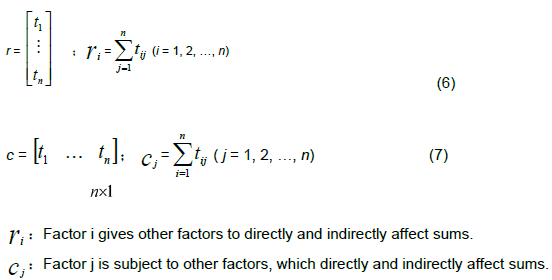
When i = j,

is called the correlation degree, namely sum of the given and giving. It high value means factor i is the important factor for the problem.

is called cause degree, namely the difference between given and giving. If it is positive, the giving is greater than the given and factor i tends to be influential factors, which can be classified as cause of the problem. If negative, the giving is less than the given, and i tend to be influenced, which can be classified as the result for the problem.
E. Draw causal-effect map: In the causality diagram, (D+R) is the horizontal axis and (D-R) vertical axis. The horizontal axis takes (D+R) average value as demarcation line, and the vertical axis takes 0 as boundary. Then, the causality diagram is divided into four quadrants, which represents different meanings. The first quadrant is the core factor with high center and high cause degree, which is the key factor to solve the research subject. The second quadrant is the driving factor with low center but high cause degree and high independence, which may affect few other factors. The third quadrant is the independent factor with low center, low cause degree and low interaction, which is available for controlling factors in this area. The fourth quadrant is the affected factor with high center but low cause degree , which is urgent because it is managed not for direct improvement, but can be improved as soon as factors in the first quadrant and second quadrant are controlled well.
Heng and Chen (2011) believe that the index for green supply chain can be demonstrated by environmental performance, adaptability of green ideas and resource utilization efficiency. And the existing evaluation index contains service ability, technology ability, long-term resources, etc. (Hsu et al., 2007). Wang (2005) summarized the evaluation of overall level of the logistics industry’s sustainable development from environmental situation,, resource utilization, economic level, level of science and technology and social development (Lin et al., 2012). Therefore, the paper assesses logistics vendor selection system from the environment, resources, economy and technology. The explanation for those aspects is shown as follows.
The first dimension: Environmental attribute
In the logistics system, the environmental attribute refers to the degree of friendliness in each link of the logistics system, including atmospheric pollutants in the process of transportation, noise pollution, solid waste pollution of facilities and equipment in packaging or circulation processing, waste water pollution in loading and unloading. The slighter air pollution, noise pollution, solid waste pollution and water pollution are, the better environmental logistics system performs.
The second dimension: Resource attribute
In the logistics system, the resource attribute mainly includes the utilization of recycled materials, the use of facilities and equipment and green energy. The reuse of recycled packaging materials, renewable resources, recycling materials, as well as control of non-environmentally friendly materials are effective ways to reduce the consumption of raw materials. The availability of facilities and equipment required in logistics is measured by the rate which is an important index of facilities and equipment resources. Meanwhile, the energy consumption in logistics transportation and handling, as well as use rate of alternative energy are also important indexes of green energy resources.
The third dimension: Economic attribute
The economic attribute in the logistics system includes the enterprise’s logistics cost, logistics service performance and the cost of ecological environment. Among them, the logistics cost consists of activity-based costing, information service cost and management cost. The performance of supply chain logistics system is evaluated from the control ability of customer market, the level of customer service, the accurate rate of delivery, post-sales service (complaints), construction of corporate culture and environmental awareness. Advanced logistics equipment is mainly reflected by the automation degree of logistics equipment, energy consumption performance, safety and environmental friendliness. The better the performance and the lower the cost, the better the economic attribute of logistics system.
The fourth dimension: Technical attribute
The technical attribute mainly takes the technology and ability of logistics into account. The traditional logistics is labor-intensive industry, while modern logistics is carried out on the basis of science and technology network. It can be estimated from the advanced logistics equipment, information of logistics management and logistics capability. Among them, advanced logistics equipment is mainly reflected by automation degree of logistics equipment, energy consumption performance, safety and environmental friendliness. In addition, the logistics management information on the basis of Geographic Positioning System (GPS) and Electronic Data Interchange (EDI) not only improves sharing degree of logistics information, but also enhances the efficiency of logistics operation. And the ratio of senior talents, technological innovation ability, the external integration ability of enterprises, and Research and Development (R&D) technology are all logistics capabilities.
In summary, this paper divides selection rules of logistics enterprise into four major dimensions and thirteen criteria, whose explanations are shown in Tables 1 and 2. Secondly, the importance of factors is evaluated according to the questionnaire data. Grade range from 0 to 5, where 0 means no influence, 1 represents little impact, 2 symbolizes low impact, 3 means moderate degree, 4 means high degree and 5 means very high impact, to summarize importance evaluation as shown in Table 3. It is demonstrated from the table that the selection rules of green logistics companies consist of the use of green energy resources, evaluation of solid waste pollution, logistics cost, ecological cost, etc. In Table 4, it shows that the value of each column is D, and the value of each row is R, (D + R) represents the total effect (center degree) of the criterion, (D-R) represents the net effect of the criterion (cause degree). X axis: D + R, Y axis: D-R, The midline is the average of each criterion (D + R) value D+R as shown in Table 5.
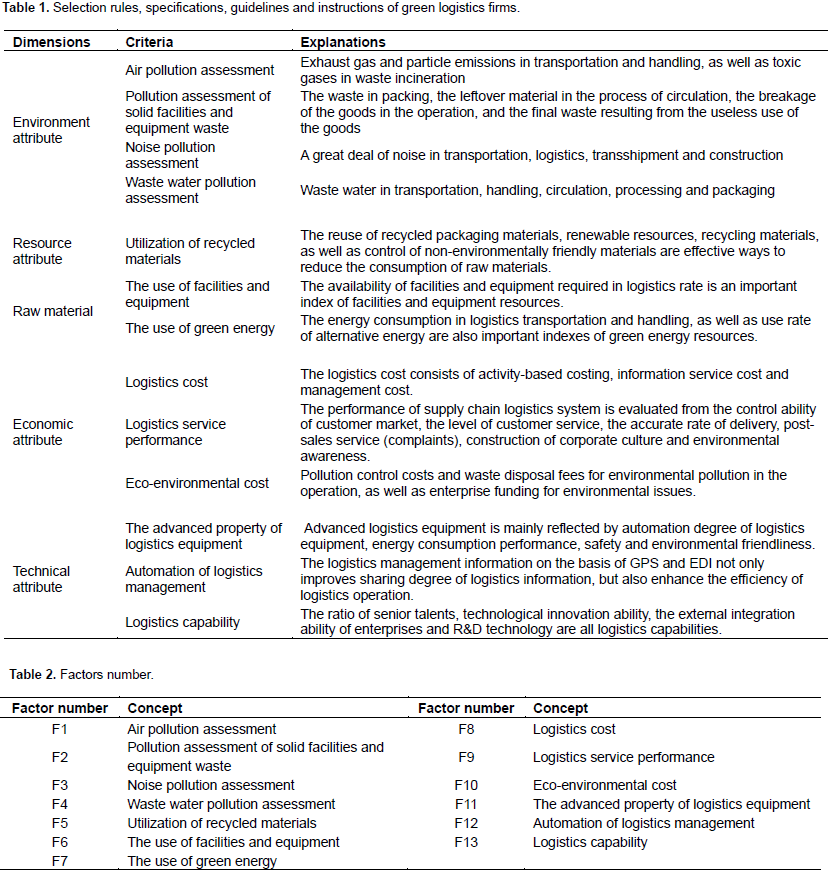
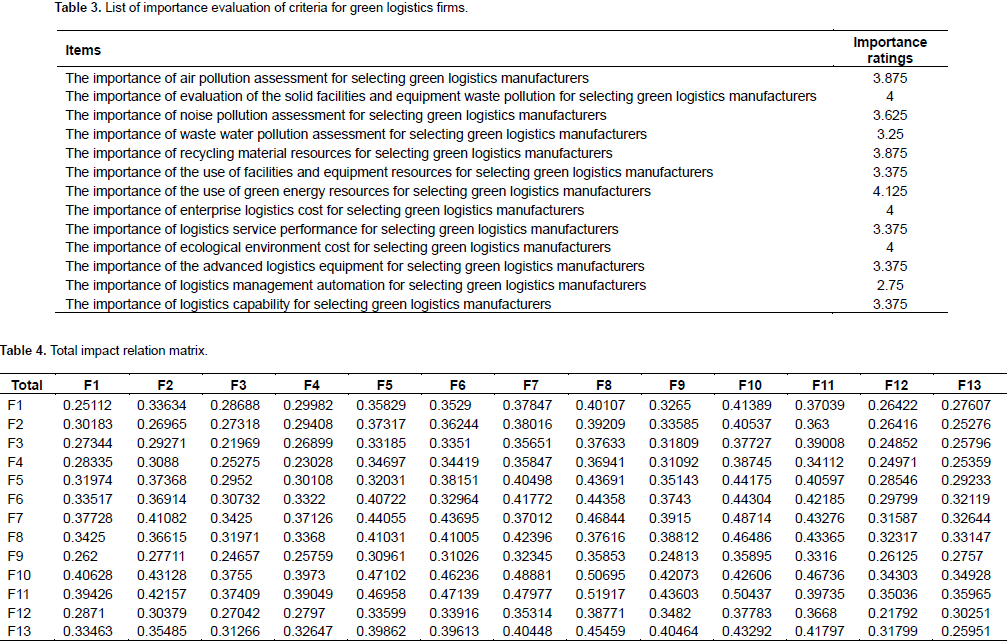
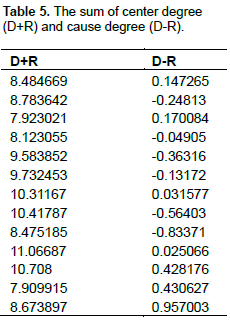
In order to identify the causal relationship between DEMATEL criteria, executive opinions on main logistics enterprises in
Fuzhou are investigated through a
questionnaire. And according to the questionnaire, the cause-effect diagram is drawn using DEMATEL method as shown in Figure 1. Based on the cause-effect diagram for selection rules of green logistics companies, thirteen criteria are summarized as shown in Figure
1 . The first quadrant is core factors, including advanced logistics equipment, ecological cost and the use of green energy. The second quadrant is driving factors, including air pollution evaluation, noise pollution assessment, automation of management logistics and logistics capability. The third quadrant is independent factors, which consist of evaluation of solid waste pollution, water pollution evaluation and logistics service performance. The fourth quadrant is the influenced factors, including the use of recycled material resources, the utilization of equipment resources, as well as logistics
cost.
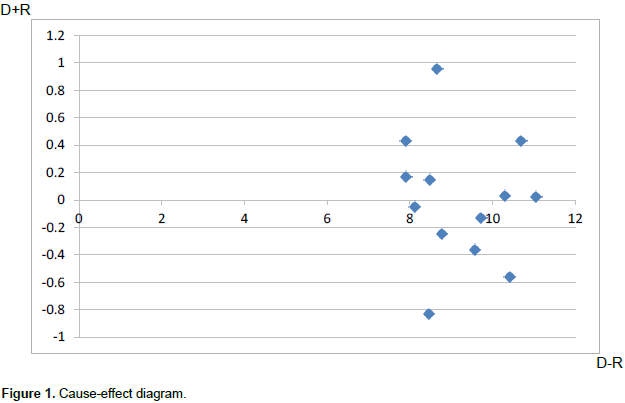
The advanced logistics equipment is an important factor in the selection of green logistics manufacturers. The advanced logistics equipment is mainly reflected by automation degree of logistics equipment, energy consumption performance and safety and environmental friendliness.
1. The utilization of recycled material resources, the use of facilities and equipment, as well as logistics cost can be improved as soon as the use of green energy resources, environmental cost, advanced logistics equipment, air pollution evaluation, noise pollution assessment, automation of logistics management and logistics capability are available and better.
2. Assessment of atmospheric pollution, evaluation of solid facilities and equipment waste pollution are important in the environmental attribute. The use of greenenergy resources is of great importance in resource attribute. Logistics and ecological costs are essential in the economic attribute. Lastly, advanced equipment and logistics
. capability play an important role in technical
attribute.
According to analysis of the cause-effect diagram, advanced logistics equipment is an important factor for the selection of green logistics firms. Therefore, green logistics companies should strengthen the advanced property of logistics equipment, in order to reduce the energy consumption. At the same time, automation of logistics equipment needs improvement, which is helpful to environmental pollution.
The authors have not declared any conflict of interests.
REFERENCES
Ashtiani GP, Bosak E (2013). A conceptual model for factors affecting the relationship between supply chain integration and customer delivery performance. Int. J. Acad. Res. Bus. Soc. Sci. 3(9):495-505.
Crossref |
|
|
Chang B, Chang CW, Wu CH (2011). Fuzzy DEMATEL Method for Developing Supplier Selection Criteria. Expert Syst. Appl. 38:1850-1858.
Crossref |
|
|
|
Guochuan Y (2010). Restriction Factors and Countermeasures in the Development of Green Logistics in China. Bus. Econ. Manage. pp. 218-223. |
|
|
|
Heng D, Chen HQ (2011). The Evaluation and Research on Logistics Suppliers Based on Green Supply Chain. Logistics Technol. 30(12):192-195. |
|
|
|
Hsu CY, Chen KT, Tzeng GH (2007). FMCDM with Fuzzy DEMATEL Approach for Customers' Choice Behavior Model, International J. Fuzzy Syst. 9(4):236-246. |
|
|
|
Lin WR, Wang YH, Hung TE (2012). Selecting Mobile Banking System Service for Consumers by Using a Combined DEMATEL and ANP Approach. J. Account. Financ. Manage. Strateg. 7(1):1-14. |
|
|
|
Sun L (2012). Analysis of the Development of Green Logistics at Home and Abroad. Modern Bus. Ind. 21:87. |
|
|
|
Wan M (2010). Research on Green Evaluation of Suppliers Based on Green Supply Chain. Logistics Technol. 11:112-114. |
|
|
|
Wang C (2005). Preliminary exploration of Evaluation Index System of Sustainable Development of Logistics Industry, Econ. Manage. 1:38-40. |
|
|
|
Wu JS, Gao, LP, Zan M (2014). SaaS Risk Recognition Based on DETAMEL. J. Guangdong Univ. Technol. 31(4):26-30. |
|
|
|
Yuan Y (2014). Supplier Selection Decision Model Based on Hybrid VIKOR Method, Control Decis. Making, 29(3):551-559. |
|
|
|
Zheng X (2015). Research on the Selection of Green Logistics Suppliers based on Fuzzy Multiple Criteria, Tianjin University of Technology. |
 is called the correlation degree, namely sum of the given and giving. It high value means factor i is the important factor for the problem.
is called the correlation degree, namely sum of the given and giving. It high value means factor i is the important factor for the problem.  is called cause degree, namely the difference between given and giving. If it is positive, the giving is greater than the given and factor i tends to be influential factors, which can be classified as cause of the problem. If negative, the giving is less than the given, and i tend to be influenced, which can be classified as the result for the problem.
is called cause degree, namely the difference between given and giving. If it is positive, the giving is greater than the given and factor i tends to be influential factors, which can be classified as cause of the problem. If negative, the giving is less than the given, and i tend to be influenced, which can be classified as the result for the problem.